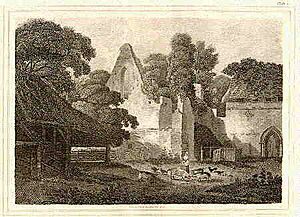Alice Baldwin (abbess) facts for kids
Quick facts for kids
Alice Baldwin
|
|
|---|---|
| Died | 1546 |
| Parent(s) | Sir John Baldwin, Agnes Dormer |
Alice Baldwin (died 1546) was the last Abbess of Burnham Abbey in England. An Abbess was the leader of a group of nuns in a religious community. Alice Baldwin was the daughter of Sir John Baldwin, who was a very important judge called the Chief Justice of the Common Pleas.
Alice Baldwin's Family
Alice Baldwin's father was Sir John Baldwin (who died in 1545). He was a very important judge in England. Her mother was Agnes Dormer.
Alice had a brother named William. She also had two sisters, Pernell and Agnes. Sadly, all her siblings passed away before she did.
Life as an Abbess
Alice Baldwin became the leader, or Abbess, of Burnham Abbey in Buckinghamshire in 1536. This Abbey was a special religious place for nuns. It was first started in 1265 by Richard, 1st Earl of Cornwall. He was the brother of King Edward III.
During the time of King Henry VIII, a big change happened in England. It was called the Dissolution of the Monasteries. This meant the King closed down many monasteries and abbeys. Burnham Abbey was one of them.
On September 19, 1539, Alice Baldwin and the nine nuns living there signed a document. This document officially gave the Abbey to the King. Because she agreed to this, Alice Baldwin was given a small pension. A pension is like a regular payment to help someone live.
After the Abbey closed, Alice likely lived with her father, Sir John Baldwin, in Aylesbury. Her father made sure she had enough money and land for her life.
Later Life and Legacy
Sir John Baldwin passed away on October 24, 1545. Alice Baldwin died just a few months later, in 1546.
In her will, Alice asked for a special tomb to be built for her father. She wanted it to show figures of her father, mother, and their children. It seems her executor, Richard Cupper, did build this tomb. However, no trace of it remains in Aylesbury Church today.
Burnham Abbey itself was later given to other people by the Crown. In 1916, it was sold to another religious group. So, after many centuries, it once again became a home for nuns.


